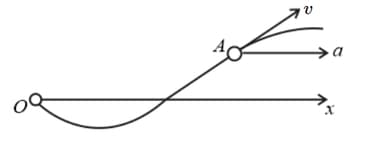Using the conditions of the foregoing problem, draw the approximate time dependence of moduli of the normal and tangent acceleration vectors, as well as of the projection of the total acceleration vector on the velocity vector direction.
Foregoing problem:- A body is thrown from the surface of the Earth at an angle to the horizontal with the initial velocity . Assuming the air drag to be negligible, find,
the time of motion,
the maximum height of ascent and the horizontal range; at what value of the angle they will be equal to each other,
the equation of trajectory , where and are displacements of the body along the vertical and the horizontal respectively,
the curvature radii of trajectory at its initial point and at its peak.

Important Questions on PHYSICAL FUNDAMENTALS OF MECHANICS
A balloon starts rising from the surface of the Earth. The ascension rate is constant and equal to . Due to the wind the balloon gathers the horizontal velocity component , where is a constant and is the height of ascent. Find how the following quantities depend on the height of ascent.
the horizontal drift of the balloon ,
the total, tangential, and normal accelerations of the balloon.
the equation of the particle's trajectory
the curvature radius of trajectory as a function of .
A particle moves in one direction along a given trajectory with a tangential acceleration , where is a constant vector coinciding in direction with the -axis, and is a unit vector coinciding in direction with the velocity vector at a given point. Find how the velocity of the particle depends on , provided that its velocity is negligible at the point .

A point moves with deceleration along the circle of radius so that at any moment of time, its tangential and normal accelerations are equal in moduli. At the initial moment , the velocity of the point equals . Find,
the velocity of the point as a function of time and as a function of the distance covered .
the total acceleration of the point as a function of velocity and the distance covered.
